Gardens
IN BANJA KOVILJAČA, BELOW GUČEVO, AN OLD OUTDOOR TREASURY
The Park with Royal geometry
There, in excerpts of manuscript of old park masters, you will find the varieties that cannot be found anywhere else in this part of Europe. You will also see those that force us, with their toughness and combativeness, to reflect upon their symbolism. You will also be puzzled by some local ones that, according to books, cannot survive here. You will stop at the crown-shaped flower garden. Reasons to be proud, but also reasons to worry, are plenty. Finally, Banja has started addressing both with full seriousness
Text and photographs: Nenad Marković
 More than a hundred years ago, across the ocean, when preparing parcels of seedlings of North-American tree Taxodium distichum intended for the park in Banja Kovilјača, someone made a mistake. They didn’t notice that a small seedling of Taxodium ascendens was hidden among them. Thanks to this, Banja Kovilјača today has a unique tree in Serbia. In the vicinity of the Banja Tower, between ”Herzegovina” and ”Dalmatia” Villas, its interesting treetop attracts attention. More than a hundred years ago, across the ocean, when preparing parcels of seedlings of North-American tree Taxodium distichum intended for the park in Banja Kovilјača, someone made a mistake. They didn’t notice that a small seedling of Taxodium ascendens was hidden among them. Thanks to this, Banja Kovilјača today has a unique tree in Serbia. In the vicinity of the Banja Tower, between ”Herzegovina” and ”Dalmatia” Villas, its interesting treetop attracts attention.
The secret of this tree was hidden for a long time. For decades. Only in the mid 1990’s, during his stay in Kovilјača, it was noticed by professor Aleksandar Tucović. In the group of Taxodium distichum, the varieties that exists in Serbia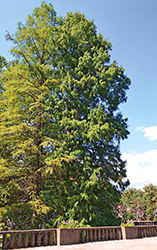 , there was a tree growing that stood out with the position of its twigs and with unusual treetop. Interested, professor Tucović began a research. In the scientific work published nine years later by him and professor Mirjana Ocokolјić, they disclosed that in the area of Serbia, as far as it is known, such a tree does not exist anywhere else. , there was a tree growing that stood out with the position of its twigs and with unusual treetop. Interested, professor Tucović began a research. In the scientific work published nine years later by him and professor Mirjana Ocokolјić, they disclosed that in the area of Serbia, as far as it is known, such a tree does not exist anywhere else.
Branko Milošević, a landscape architect in the Directorate for Management and Development of Banja Kovilјača, says that this unique tree was probably planted during the first landscaping of this park.
– There is no data about the planting of this tree, and at that time, in 1996, its age was estimated at nine decades. It is almost certain that it arrived by mistake, together with the ordered seedlings Taxodium distichum. It is a deciduous conifer whose needles in the fall turn brown and fall with the twigs, and then grow green again in the spring. It is much more ornamental than Taxodium distichum, and it has proven to be more adaptable to conditions of draught. We will try to reproduce it, in order to avoid the risk of someone felling it by mistake or out of ignorance. Vegetative reproduction is like cloning, and the young trees would keep the genetic information of the ”mother plant” – Milošević explains.
LITTLE ANTHOLOGY OF VARIETIES
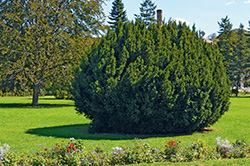 This tree is not the only one that draws attention in the park of Banja Kovilјača. not far from it, a pair of Japanese ginkgo trees are growing, a tertiary relict tree like our just like our spruce, which has high medicinal properties, is very adaptable and resilient. After the horrific atomic attacks on Hiroshima and Nagasaki, the ginkgo trees were the first to recover and turn green. Generally, there are male and female trees, and in the parks one should avoid the former because of abundance of seeds they create, because the seed shell has a very unpleasant odor. This tree is not the only one that draws attention in the park of Banja Kovilјača. not far from it, a pair of Japanese ginkgo trees are growing, a tertiary relict tree like our just like our spruce, which has high medicinal properties, is very adaptable and resilient. After the horrific atomic attacks on Hiroshima and Nagasaki, the ginkgo trees were the first to recover and turn green. Generally, there are male and female trees, and in the parks one should avoid the former because of abundance of seeds they create, because the seed shell has a very unpleasant odor.
There are very few Serbian spruce trees, ginkgo’s peer from the tertiary, in this park, only tree trunks. There is a lot of water in the soil (the Drina used to run through this area along Gučevo) and this tree does not like it. Milošević says that they will try to reproduce it on the slopes above Banja, so that this unique Serbian tree, which in nature grows only in a narrow strip on the mountain of Tara, would have better chance for survival. The soil is not suitable also for domestic fir threes, of which there are around twenty, and almost all black pine trees are jeopardize.
 Among them is a magnificent example of black pine tree that was, according to a legend, planted personally by King Petar I Karađorđević in 1923. On a small elevation, although it has survived in the soil that does not befit it, the beautiful tree was not able to withstand the attack of pests. Bark beetles, whose attack was recorded as early as in 1987, have eaten and ruptured it to quite an extent. When the voracious beetle inflicts enough damage, the pine tree will remain without food and begin to dry. This amazing antiquity is still holding on, but the end is inevitable. Techniques for destroying beetles are very expensive, and it is difficult to solve the issue of feasibility. Among them is a magnificent example of black pine tree that was, according to a legend, planted personally by King Petar I Karađorđević in 1923. On a small elevation, although it has survived in the soil that does not befit it, the beautiful tree was not able to withstand the attack of pests. Bark beetles, whose attack was recorded as early as in 1987, have eaten and ruptured it to quite an extent. When the voracious beetle inflicts enough damage, the pine tree will remain without food and begin to dry. This amazing antiquity is still holding on, but the end is inevitable. Techniques for destroying beetles are very expensive, and it is difficult to solve the issue of feasibility.
Not far from ”Podrinje” Hotel, a few hundred years old sequoia rises toward the sky. Most likely, they will attempt to reproduce it, because this variety in Serbia has begun to dry.
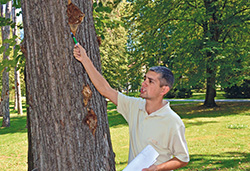 – This park is also special because in it, as in very few other places, various varieties are fitted together. European yew tree grows here, not far from it magnolia kobus that has white flowers, and right next to it a red-leaved beech, a very rare varieties on green surfaces – Milošević says. – Our hundred years old European yew trees, a tree that, according to popular belief, protects from evil spirits, are actually very young. In this region they may live for up to 4,000 years. In Serbia it is a protected varieties. Everything on European yew tree, except the seed, is poisonous, but only if it is ingested. – This park is also special because in it, as in very few other places, various varieties are fitted together. European yew tree grows here, not far from it magnolia kobus that has white flowers, and right next to it a red-leaved beech, a very rare varieties on green surfaces – Milošević says. – Our hundred years old European yew trees, a tree that, according to popular belief, protects from evil spirits, are actually very young. In this region they may live for up to 4,000 years. In Serbia it is a protected varieties. Everything on European yew tree, except the seed, is poisonous, but only if it is ingested.
The Banja guests like to relax on the benches in a shade, around the fountain, in the center of the park. The shade is made by the ash leaf maple trees, a sub-variety of maple, which is generally regarded as weed on green surfaces. They have been here since the construction of the park, and there is no plan to replace them with a more precious variety. Although at the age of around one hundred years the ash leaf maple tree dies young, it tolerates pruning excellently and will stay in its location especially because of the unusual treetop.
WITH THE POWER OF THE OLD HAWTHORN
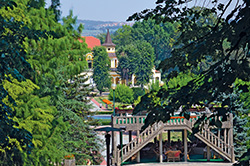 During the park construction, they paid attention to plant the trees on the rim, in order to create favorable micro-climate conditions in the center of it, and isolate it from air pollution. There are more than a hundred varieties growing here, making this area unique. Some adorn it with their scent, like lime tree, some have anti-bacterial effect, such as Norway maple, and protect the surrounding trees, because they are avoided by insects. During the park construction, they paid attention to plant the trees on the rim, in order to create favorable micro-climate conditions in the center of it, and isolate it from air pollution. There are more than a hundred varieties growing here, making this area unique. Some adorn it with their scent, like lime tree, some have anti-bacterial effect, such as Norway maple, and protect the surrounding trees, because they are avoided by insects.
Individual trees in the park are approaching the end of their natural development and it is time to prepare for their replacement. People didn’t think much about this before, but now they will make sure to plant the varieties for which this is the natural habitat, such as oak or hornbeam, as well as those conifer varieties that proved to be more resilient.
– The problem is that no forestation systems were developed earlier, and mistakes were also made. It is now our goal to restore the park into its original condition. We have begun to plant new trees. For now, we have been copying the forest, planting those varieties that grow naturally, but later we will also introduce other interesting varieties – the landscape architect from Banja tells us. – This is a historic park, and we must also preserve the black pine trees, as much as possible. The condition in the park is getting better, the irrigation system is working, we have been increasing surfaces under flowers, since we initiated nursery production and achieved savings. We have also reconstructed two thirds of the lawn, but the floods interrupted us in this work and forced new tasks upon us. Now, from the surface area of about two hectares, we have ben removing sludge, after which we will bring new soil. Designs for two wells are completed. We will try to make at least one, which would cost about three million dinars, but would bring savings and would pay off in two years.
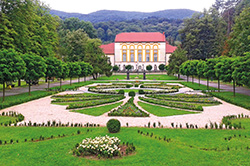 The Royal Park in Banja Kovilјača has been changing with time. Historical changes influenced this also. We are now creating theme flower gardens. The goal is to adapt the changes to the present time. By building the parterre, the story about the old park was told, and gritting material was spread in order to evoke the paths as they used to be. Near the monument to two kings – King Petar I the Liberator and Aleksandar the Unifier, a flower garden was made in the shape of a royal crown. (The park paths used to be made in the shape of a crown.) Flower fans evoke pheasant’s tail, the bird that has been a symbol of royal gardens from ancient times. The Royal Park in Banja Kovilјača has been changing with time. Historical changes influenced this also. We are now creating theme flower gardens. The goal is to adapt the changes to the present time. By building the parterre, the story about the old park was told, and gritting material was spread in order to evoke the paths as they used to be. Near the monument to two kings – King Petar I the Liberator and Aleksandar the Unifier, a flower garden was made in the shape of a royal crown. (The park paths used to be made in the shape of a crown.) Flower fans evoke pheasant’s tail, the bird that has been a symbol of royal gardens from ancient times.
The history of the park and its struggle to survive are maybe best symbolized by the hawthorn that grows near the path in the vicinity of the Special Hospital for Rehabilitation ”Banja Kovilјača”. Although the bark beetles have almost completely eaten it, and damaged in that way was again hit by heavy moist snow few years ago, and although only one third of the trunk is all that is left of the entire tree, a branch that lives and bears leaves has grown on that stub.
***
Natural Good
The Park in Banja Kovilјača is a natural good of regional significance, of the second category, with regime of protection of the third degree. The procedure has not been finalized, but it has been placed under protection already at the moment of initiating the study on protection in 2005. There is a total of 40 hectares of protected area, 13 in the lower part of the park. More than a hundred varieties grow there, 49 broad leaved, 30 conifer and around 30 varieties of shrubs.
***
Classical Park
The Park in Banja, Milošević says, is a typical example of a classic park, with baroque elements. Although there is very little data about its origin, the records on construction of the villas in Banja contain information that these villas were connected by paths with a fountain in the center.
***
Concern
The number of trees in the park is decreasing, which causes great concern. 27 years ago, there were 1,660 of them, and now there are 700 fewer than that. About fifty dry ones are waiting to be removed, and there are much more those with a disease. Trees are mostly attacked by decay, and fungi it causes have primarily attacked lime trees and are already throwing their fruit bearing bodies. Although it can survive for another ten-twenty years, it is a clear indicator that the tree is rotting inside and it most often dies under the weight of moist snow. The initiated forestation will improve the situation, and in the Directorate they have decided to first introduce the varieties that tolerate the conditions of alluvial habitat, so that the same.
|
